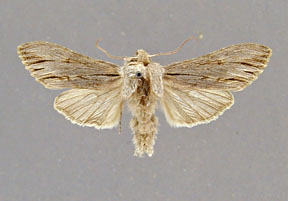
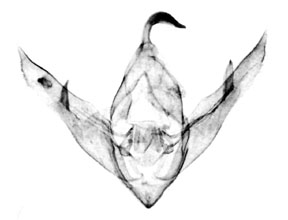
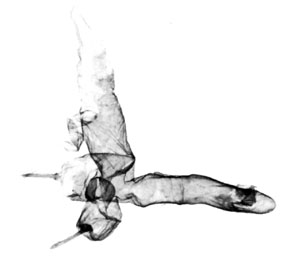
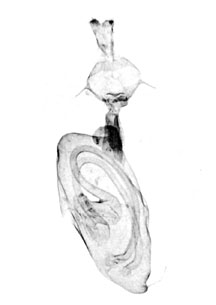
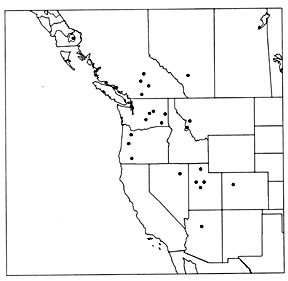
|
Cucullia strigata (Smith)
Rancora strigata Smith, 1892, Ent. News,
3:253, pl. 10, upper left corner.
Rancora brucei Smith, 1903, Canad. Ent.,
35:136.
Rancora ketchikana Barnes and Benjamin, 1922, Contrib.
Nat. Hist. Lep. N. Am., 5(1):30.
Diagnosis: Cucullia strigata is characterized
by; 1) the fairly uniform dark gray color of the forewing, 2) the presence
of dark, prominent black streaks in the terminal and subterminal areas
of the forewing, 3) a prominent black basal dash in the forewing, and
4) the dark coloration of the hindwing in both males and females. Unfortunately
all of these characters are subject to a pronounced within population
variability. In particular the black streaks on the forewing vary from
pronounced with black accenting to almost entirely absent. The color of
the male hindwing varies from brown to white with patches of dark brown
scales.
Cucullia strigata may be separated from serraticornis
by the darker, more uniform gray forewing color, the brown coloration
of the male hindwing, and the presence of black streaks on the forewing.
The differences in both the male and female genitalia between strigata
and serraticornis are discussed under serraticornis
but in summary involve a much longer neck of the ovipositor and ductus
bursae in strigata and the wider clasper in the male valve. Cucullia
strigata is usually much darker than albida. There are small
differences in the male genitalia between albida and strigata.
In particular the apex of the valve is slightly more strongly produced
in strigata. However the variability within a species and between
species is so broad that I am not sure this difference will be consistently
true. The major genitalic difference between the two species is found
in the female. The ovipositor neck is about as long as wide albida.
In contrast the ovipositor neck is approximately 3 times longer than wide
in strigata. The two species appear to be mostly allopatric,
but there are indications of some overlap in their ranges. For example
there are specimens of both species labeled Calgary, Alberta. The types
of albida and of one of the synonyms of strigata (brucei)
are both labeled Garfield County, Colorado. Curiously, perhaps, in all
of the material collected by Barnes at Glenwood Springs, the presumed
collecting locality in Garfield County, there are no specimens of albida.
Calgary, Alberta as a locality was used in a very broad sense in earlier
days. Therefore neither case of range overlap can be considered proven.
Wing length from base to apex: mean = 21.74 mm., standard deviation =
0.53 mm., n = 10.
Distribution: Cucullia strigata is primarily
a species of the Pacific Northwest and the Great Basin. It occurs in Utah
and western Colorado, Oregon, north through Washington, British Columbia,
and as far north as the southern most extension of Alaska. These Alaskan
specimens were the basis of the name ketchikana and are darker than typical
strigata. The southernmost extension of the species is along the Mogollon
Rim at Sedona in north-central Arizona.
Adults have been collected in April and May.
Identification Quality: Excellent
Larva: Unknown
Foodplants: Unknown
|


